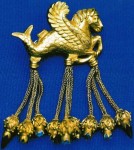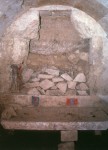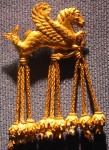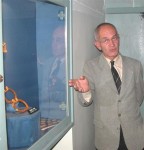 In this blog’s first month of existence, I lamented the tragic state of security at Turkish museums, which had resulted in dozens of known thefts from every museum in the country. Particularly lamentable was the theft of multiple objects, including a gold hippocampus brooch, from the Lydian Hoard kept at the Uşak Museum of Archaeology in western Turkey.
In this blog’s first month of existence, I lamented the tragic state of security at Turkish museums, which had resulted in dozens of known thefts from every museum in the country. Particularly lamentable was the theft of multiple objects, including a gold hippocampus brooch, from the Lydian Hoard kept at the Uşak Museum of Archaeology in western Turkey.
The Lydian Hoard is a collection of 363 artifacts, many of them silver and gold, that were looted from neighboring 6th century B.C. burial mounds in the Uşak and Manisa Provinces of Turkey. The treasure was said to have belonged to King Croesus of Lydia, of “rich as Croesus” fame, but there’s no specific connection to him beyond the fact that they date to around the same time as his reign. The tombs certainly belonged to royalty, but they could have been from Croesus’ family, high functionaries or even the Persian satraps who ruled after Cyrus’ crushing victory over the Lydian king in 547 B.C.
 The first tomb was discovered by looters in 1966. When they found they could not penetrate the hard marble outer walls, they used gunpowder to blow up the main entrance. Inside they found the remains of a royal woman and 125 vessels, pieces of jewelry, and sculptures in gold and silver. Looters found other richly appointed tombs in the area over the next two years. The entire haul is known as the Lydian Hoard, or the Karun (the Arabic and Persian name for Croesus) Treasure.
The first tomb was discovered by looters in 1966. When they found they could not penetrate the hard marble outer walls, they used gunpowder to blow up the main entrance. Inside they found the remains of a royal woman and 125 vessels, pieces of jewelry, and sculptures in gold and silver. Looters found other richly appointed tombs in the area over the next two years. The entire haul is known as the Lydian Hoard, or the Karun (the Arabic and Persian name for Croesus) Treasure.
The contents of the tombs and even painted pieces of the walls themselves were stripped and sold by Swiss and American middlemen to the Metropolitan Museum of Art between 1966 and 1970. The Met paid a total of $1.5 million for the Lydian Hoard, but they kept it hidden in storage for more than 20 years. Özgen Acar, a Turkish reporter who had spent years talking to the looters and following the tracks of the stolen hoard, caught wind of a potential Lydian treasure in the Met’s basement but was unable to pin it down.
 Finally, in 1984 many of the artifacts saw the light of day in a major exhibition at the Metropolitan Museum of Art. Even though the museum intentionally mislabeled them as part of an “East Greek treasure,” Acar immediately recognized them as the Lydian artifacts from the descriptions he had been given by the looters. He alerted the Turkish government. In 1986, Turkey officially requested the hoard be returned. The Met refused; Turkey sued.
Finally, in 1984 many of the artifacts saw the light of day in a major exhibition at the Metropolitan Museum of Art. Even though the museum intentionally mislabeled them as part of an “East Greek treasure,” Acar immediately recognized them as the Lydian artifacts from the descriptions he had been given by the looters. He alerted the Turkish government. In 1986, Turkey officially requested the hoard be returned. The Met refused; Turkey sued.
The legal wranglings continued until 1993 when the Met, caught red-handed by the minutes of their own acquisition committee which described how a curator had actually visited the looted burial mounds in Turkey to confirm the authenticity of the objects, agreed to return the treasure. The artifacts went on display at the Museum of Anatolian Civilizations in Ankara for two years, after which the hoard became part of the permanent collection of the museum in Uşak near the tombs where it was buried. (This whole story and more is recounted in Sharon Waxman’s excellent Loot: The Battle over the Stolen Treasures of the Ancient World.)
Turkey spent six years and 40 million dollars pursuing the Lydian Hoard in court. Yet, in 2006, the country’s entire budget for museum and archaeological site maintenance was $66 million. Even when the one-room museum in Uşak went from holding a collection of rugs to one of the greatest treasures in the country, there was no additional security installed. Add to that the remote location and tiny number of visitors to the Uşak museum, and it’s no small wonder that insiders were able to help themselves to pieces of the hard-won Lydian Hoard without anyone noticing for a year.
 The most famous and precious object from the treasure, the gold hippocampus (a mythical winged horse with the tail of a fish representing air, earth and water), had become a symbol of great pride for Uşak. It was stolen and replaced with a fake in 2005. Working on an anonymous tip, authorities found out in 2006. It weighed 23.5 grams; the original weighed 14.3 grams. It had to be an inside job and the main suspect was the museum director, Kazim Akbiyikoglu.
The most famous and precious object from the treasure, the gold hippocampus (a mythical winged horse with the tail of a fish representing air, earth and water), had become a symbol of great pride for Uşak. It was stolen and replaced with a fake in 2005. Working on an anonymous tip, authorities found out in 2006. It weighed 23.5 grams; the original weighed 14.3 grams. It had to be an inside job and the main suspect was the museum director, Kazim Akbiyikoglu.
This is one of the most heartbreaking parts of the story. Kazim Akbiyikoglu had worked assiduously to help reclaim the stolen hoard from the Met. He was a renowned archaeologist who had fought for decades against looters and had been threatened with murder and kidnapping by a prominent family who had made millions trafficking in antiquities. He was the first Turkish scholar sent to examine the Lydian Hoard during pretrial discovery when the Met was finally forced to give outside experts access to the artifact. He had submitted an affidavit attesting to the Uşakian origin of the “East Greek treasure.” Özgen Acar considered him one of the most honest men he knew.
 Akbiyikoglu and nine other staffers were arrested in 2006 and put on trial for the theft. In 2009 they were all found guilty. Akbiyikoglu was sentenced to 13 years in prison. He admitted that he had sold the hippocampus and other artifacts to pay off gambling debts, and he blamed his sad decline as a human being to the “curse” of the hoard. The authorities continued to look for the artifacts, but they weren’t optimistic. The hippocampus was so recognizable it would have been a lot easier to melt it down and sell it for its gold value than to sell it on the black market.
Akbiyikoglu and nine other staffers were arrested in 2006 and put on trial for the theft. In 2009 they were all found guilty. Akbiyikoglu was sentenced to 13 years in prison. He admitted that he had sold the hippocampus and other artifacts to pay off gambling debts, and he blamed his sad decline as a human being to the “curse” of the hoard. The authorities continued to look for the artifacts, but they weren’t optimistic. The hippocampus was so recognizable it would have been a lot easier to melt it down and sell it for its gold value than to sell it on the black market.
But hope is the last to die, as the proverb goes, and after seven years on the lam, the hippocampus has been found in Germany. There are no details on how it was discovered, where, or how it got there. All we know is German officials have agreed to return the hippocampus as soon as the end of the year.
When it goes back on display in Uşak, it will be in a brand new facility scheduled to open in December of 2013 which will hold all of the pieces (including a hundred or so additional objects discovered around the world after the Met lawsuit) of the Lydian treasure. I’m glad to see that some lessons were learned from the humiliating debacle of 2006. If you’re going to invest millions in repatriation suits, you’d better spend hella millions on security.